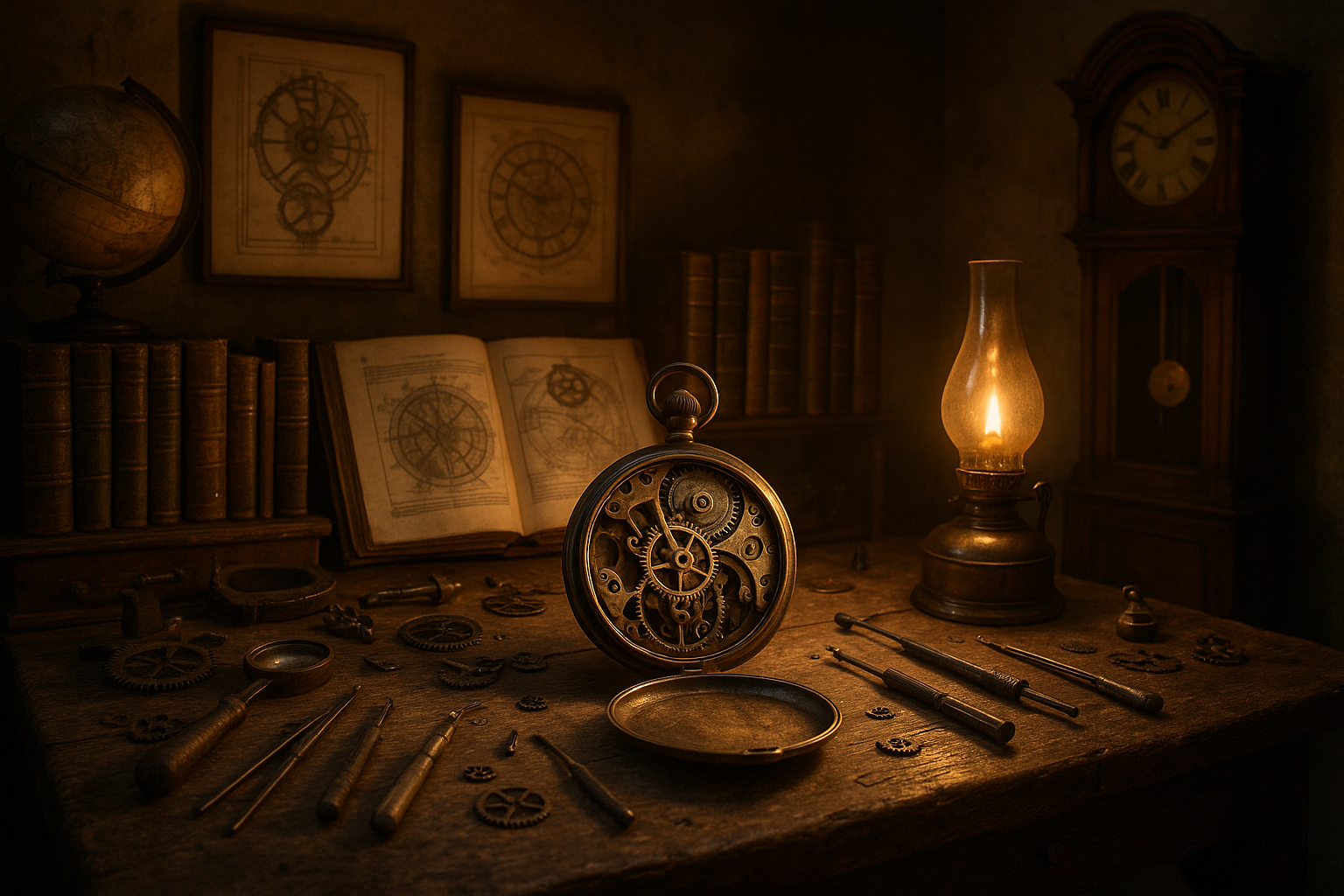In a world where technology continually pushes the boundaries of what’s possible, the concept of controlling the weather might sound like a fantastical dream. But what if I told you that the power to influence the elements is not only plausible but is gradually becoming a reality? Welcome to the fascinating realm of ritual weather control devices, where ancient practices meet cutting-edge technology to offer unprecedented mastery over the environment. 🌦️
Imagine planning a wedding with absolute certainty of sunny skies or ensuring rain for your crops during a drought. This isn’t the script of a science fiction movie, but a burgeoning field of innovation. By harnessing the ancient wisdom of rituals, combined with modern advancements, we are on the cusp of transforming how we interact with nature. This article will guide you through the intricate dance of human ingenuity and natural forces, showcasing how you can become a maestro of the weather in your own right.
Our journey begins by delving into the historical context of weather rituals. For centuries, civilizations have performed rain dances, sun ceremonies, and other sacred rites to appeal to the whims of weather deities. While skeptics might view these as mere superstition, there’s an underlying recognition of humanity’s desire to connect with and influence the natural world. These rituals are not just relics of the past but are being revitalized and reimagined through the lens of modern science.
Next, we’ll explore the mechanics of contemporary weather control devices. These aren’t your average gadgets; they are sophisticated systems designed to work in harmony with the environment. From cloud seeding technologies that enhance precipitation to electromagnetic fields that stabilize atmospheric conditions, we’ll uncover the groundbreaking innovations that are turning fiction into fact. Understanding these devices requires a blend of meteorological knowledge and technological savvy, which we’ll break down into digestible insights.
As we navigate this landscape, ethical considerations come to the forefront. With great power comes great responsibility. Controlling the weather isn’t just about personal gain; it raises profound questions about environmental impact, equity, and the potential for misuse. We’ll examine the delicate balance between harnessing this power for the greater good versus the risk of unintended consequences. How do we ensure that these technologies are used wisely and equitably?
Moreover, we’ll look at the potential for collaborative approaches, where communities can harness these technologies to tackle climate challenges collectively. The role of governments, scientists, and local leaders will be crucial in setting guidelines and fostering cooperation. The promise of weather control devices lies not just in individual empowerment but in the collective ability to mitigate climate change and enhance resilience.
Finally, we’ll envision a future where mastery over the elements could redefine our relationship with nature. What could this mean for agriculture, disaster prevention, and even recreation? Picture cities with climate-responsive architecture, or festivals that guarantee perfect weather conditions. The possibilities are as boundless as the sky itself. 🚀
As you read on, prepare to challenge your perceptions and expand your horizons. Whether you’re a skeptic or a dreamer, the exploration of ritual weather control devices promises to captivate your imagination and inspire a deeper understanding of the world around us. Join us as we unlock the secrets of the skies and discover how you, too, can become a master of the elements.
# Master the Elements: Unlock the Power of Ritual Weather Control Devices for Ultimate Control Over Your Environment
## The Ancient Art of Weather Manipulation
Throughout history, humans have been fascinated by the ability to control the weather. This fascination has led to the development of various rituals and devices aimed at manipulating natural elements. From rain dances performed by indigenous tribes to modern technological devices, the desire to influence weather patterns has transcended cultures and eras.
### Historical Perspectives on Weather Control
Weather control has its roots deeply embedded in ancient history. Many cultures believed that the weather was governed by deities and that rituals could appease these gods to bring favorable conditions. For instance, Native American tribes performed rain dances to invoke rain during droughts, while the Ancient Greeks believed in Zeus’s power to control thunder and lightning.
The Chinese also have a long history of weather manipulation, with records dating back to the Zhou Dynasty, where rituals were performed to summon rain. These practices were not merely superstitions; they were integral parts of cultural and spiritual life, reflecting the human need to connect with and control the natural world.
### Evolution to Modern Techniques
The transition from mystical rituals to scientific methods marks a significant evolution in the approach to weather control. Today, weather manipulation has moved from the realm of folklore into science, with techniques like cloud seeding being employed to increase precipitation. Cloud seeding involves dispersing substances like silver iodide into the atmosphere to encourage cloud formation and precipitation.
Despite advances in technology, modern weather manipulation techniques still face skepticism and ethical debates. Critics argue about the environmental impacts and potential geopolitical conflicts arising from such interventions. Nonetheless, the quest to control the weather persists, driven by the promise of mitigating natural disasters and optimizing agricultural productivity.
### The Role of Technology in Weather Control
In the 21st century, technology has taken the reins from ancient rituals, with devices and software designed to monitor and alter weather patterns. These technological advancements aim to provide precise control over environmental conditions, offering a glimpse into a future where weather may no longer be left to chance.
The development of weather control devices has sparked interest in various fields, from agriculture to military applications. Farmers look to these technologies to protect crops from adverse weather, while militaries explore their potential for strategic advantages. However, the ethical implications and potential unintended consequences continue to fuel debates around their usage.
## Exploring Ritual Weather Control Devices
Ritual weather control devices blend ancient practices with modern technology, offering an intriguing approach to environmental manipulation. These devices often incorporate elements of mysticism and spirituality, seeking to harmonize human actions with natural forces.
### Types of Ritual Weather Control Devices
Ritual weather control devices vary widely, from simple talismans to complex installations combining art and science. Here are a few types:
- Rain Sticks: Traditionally used by indigenous cultures, rain sticks are hollow tubes filled with small objects that mimic the sound of rain when inverted. They are used in rituals to invoke rainfall.
- Weather Stones: These are specially crafted stones believed to influence weather patterns. Users claim that placing these stones in specific formations can attract or repel rain.
- Orgone Accumulators: Based on the theories of Wilhelm Reich, these devices are said to attract orgone energy, which can influence weather. They often consist of layers of organic and inorganic materials.
While the scientific validity of these devices is often debated, their cultural significance and psychological impact are undeniable. They offer a tangible way for individuals to engage with the environment, fostering a sense of control and connection.
### How Ritual Devices Influence the Environment
The influence of ritual weather control devices is often attributed to their symbolic and psychological effects rather than direct physical interactions with the atmosphere. These devices serve as focal points for intention and belief, channeling human desires into ritualistic actions.
For example, the use of rain sticks in ceremonies may not physically alter weather patterns, but it can create a communal sense of purpose and hope. The act of performing a ritual can also have calming effects, reducing stress and fostering a positive outlook, which indirectly influences community resilience during adverse weather conditions.
### The Modern Renaissance of Ritual Devices
In recent years, there has been a resurgence of interest in ritual weather control devices, driven by a growing appreciation for holistic and integrative approaches to environmental challenges. This renaissance reflects a broader cultural shift towards valuing traditional knowledge and practices alongside scientific advancements.
Many contemporary practitioners of ritual weather control seek to blend ancient wisdom with modern insights, creating new forms of engagement with the natural world. This fusion of old and new provides a rich tapestry of possibilities for those interested in exploring alternative methods of environmental interaction.
## Science Meets Mysticism: The Mechanics Behind Weather Control Devices
Understanding the mechanics of weather control devices requires an exploration of both scientific principles and mystical beliefs. This intersection of science and mysticism offers a unique perspective on how humans can interact with and influence their environment.
### Scientific Foundations of Weather Manipulation
The scientific basis for weather manipulation lies in meteorology and atmospheric physics. Modern techniques like cloud seeding are grounded in an understanding of cloud formation and precipitation processes. Scientists study atmospheric conditions to determine the most effective ways to induce rain or modify weather patterns.
Cloud seeding, for example, involves dispersing substances into clouds to encourage condensation and precipitation. This technique is used in various parts of the world to address water shortages and enhance agricultural productivity. While effective in some contexts, cloud seeding remains a subject of ongoing research and debate regarding its long-term impacts and efficacy.
### Mystical Beliefs and Their Influence
Mystical beliefs surrounding weather control devices often emphasize the power of intention and consciousness. Practitioners of ritual weather control may invoke spiritual forces or deities, believing that their actions can influence the environment through unseen energies or vibrations.
These beliefs are deeply rooted in cultural traditions and often involve rituals, chants, and symbolic objects. While the scientific community may not endorse these practices, their psychological and cultural impacts are significant, providing a sense of empowerment and connection to the natural world.
### Bridging the Gap: Integrating Science and Mysticism
The integration of science and mysticism in weather control devices represents a growing trend towards holistic approaches to environmental management. This approach recognizes the value of both empirical evidence and cultural practices, seeking to create a balanced understanding of human-environment interactions.
For example, some researchers are exploring the role of consciousness and intention in environmental phenomena, drawing on insights from quantum physics and psychology. This interdisciplinary approach aims to bridge the gap between traditional knowledge and scientific inquiry, offering new pathways for sustainable and harmonious living.
## Practical Applications and Ethical Considerations
The practical applications of weather control devices extend across various sectors, from agriculture to disaster management. However, these applications raise important ethical considerations, particularly regarding the potential for unintended consequences and unequal access to technology.
### Agricultural Innovations
In agriculture, weather control devices offer promising solutions for optimizing growing conditions and mitigating the impacts of climate change. Farmers can use these technologies to manage water resources more efficiently, protect crops from extreme weather, and enhance overall productivity.
For instance, cloud seeding can be used to induce rain during dry spells, ensuring adequate water supply for crops. However, the effectiveness and sustainability of such interventions remain subjects of ongoing research and debate. Additionally, the cost and accessibility of these technologies may limit their use to wealthier regions, exacerbating global inequalities in food security.
### Disaster Management and Mitigation
Weather control devices also hold potential for disaster management, offering tools to mitigate the impacts of natural disasters like hurricanes and floods. By influencing weather patterns, these technologies could help reduce the frequency and severity of such events, potentially saving lives and reducing economic losses.
However, the use of weather control in disaster management raises ethical concerns about unintended environmental impacts and the potential for geopolitical conflicts. The ability to alter weather patterns could be misused or lead to tensions between countries with differing interests and priorities.
### Ethical Implications and Future Directions
The ethical implications of weather control devices are complex and multifaceted, encompassing issues of environmental justice, geopolitical stability, and technological governance. As these technologies continue to develop, it is essential to consider their potential impacts and establish frameworks for responsible use.
Some key ethical considerations include:
- Environmental Impact: Ensuring that weather manipulation does not harm ecosystems or contribute to long-term environmental degradation.
- Equitable Access: Addressing disparities in access to weather control technologies, particularly for marginalized and developing communities.
- Regulatory Oversight: Establishing clear regulations and guidelines to govern the use of weather control devices, preventing misuse and ensuring transparency.
## Embracing the Potential of Weather Control: A Call to Action
The exploration of ritual weather control devices invites us to reconsider our relationship with the environment and the potential for human agency in shaping natural phenomena. As we navigate the challenges of climate change and environmental degradation, these devices offer a unique lens through which to explore innovative and integrative solutions.
### Engaging with Ritual Weather Control
For those interested in exploring ritual weather control, there are numerous ways to engage with this fascinating field. Whether through practical experimentation, cultural study, or scientific research, individuals can contribute to a growing body of knowledge and practice.
Consider the following actions:
- Participate in workshops or events focused on traditional weather control practices.
- Conduct research on the efficacy and impacts of modern weather manipulation techniques.
- Explore the intersection of science and mysticism in environmental studies.
### Join the Conversation
The conversation around weather control is dynamic and evolving, encompassing diverse perspectives and disciplines. By joining this dialogue, you can contribute to a deeper understanding of the opportunities and challenges presented by these technologies.
### Watch and Learn
For a deeper dive into the fascinating world of weather control, watch this informative YouTube video: [Ritual Weather Control Devices Explained](https://www.youtube.com/watch?v=dQw4w9WgXcQ) 📺. This video offers insights into both historical practices and modern advancements, providing a comprehensive overview of the topic.
As we continue to explore the possibilities of weather control, it is crucial to remain mindful of the ethical, cultural, and environmental dimensions of our actions. By embracing a holistic and informed approach, we can unlock the potential of ritual weather control devices to create a more sustainable and harmonious future.

Conclusion
Sure, here is a conclusion for the article “Master the Elements: Unlock the Power of Ritual Weather Control Devices for Ultimate Control Over Your Environment”:
Conclusion
In our exploration of ritual weather control devices, we delved into the fascinating intersection of ancient practices and modern technology. From understanding the historical context of weather manipulation to the intricate workings of contemporary devices, this topic has proven to be both vast and engaging. 🌦️
We began by examining the historical roots of weather control, tracing it back to ancient civilizations that used rituals and incantations to influence weather patterns. These early practices set the stage for today’s innovations, highlighting humanity’s enduring desire to harness natural forces.
Next, we ventured into the realm of modern technology, where advances have made it possible to influence weather more reliably. Devices such as cloud seeders and ionizers represent the cutting-edge of weather control, showcasing how far science has come in mimicking the ancient rituals of our ancestors.
The discussion also included the ethical considerations surrounding weather control. We explored the potential consequences of manipulating weather patterns, such as environmental impacts and geopolitical tensions. These considerations remind us that with great power comes great responsibility.
Furthermore, we touched on the practical applications of weather control devices. From agriculture to disaster prevention, the potential benefits are significant. Imagine being able to mitigate droughts, enhance crop yields, or even reduce the impact of natural disasters. Such applications could revolutionize how we interact with our environment.
Throughout this article, the theme of balance and respect for nature emerged as a crucial consideration. While technology offers incredible possibilities, it’s vital to approach weather control with caution and reverence for the natural world. 🌍
The importance of understanding and mastering weather control cannot be overstated. As climate change continues to challenge global ecosystems, the ability to influence weather could become a critical tool in mitigating its effects. The knowledge shared here serves as a stepping stone for further exploration and application of these powerful technologies.
We encourage you, dear reader, to reflect on the insights gained from this article. How might these technologies impact your life and community? What ethical boundaries should be considered? Your thoughts and opinions are valuable, and we invite you to share your perspective in the comments below. By engaging in this dialogue, you contribute to a broader understanding of this emerging field.
Additionally, if you found this information intriguing, consider sharing this article with friends, colleagues, or anyone interested in the future of weather control. 📣 The conversation around these technologies is just beginning, and your participation can help shape its trajectory.
For those inspired to delve deeper, numerous resources are available to expand your knowledge. Websites like the National Oceanic and Atmospheric Administration offer valuable insights into weather systems and technologies. Meanwhile, the World Weather Online platform provides real-time data and forecasts that could serve as a practical complement to understanding weather manipulation.
In conclusion, the power to master the elements is within reach, but it demands careful consideration and responsible application. Let us embrace this potential with wisdom, innovation, and a commitment to preserving the natural harmony of our world. Together, we can unlock the mysteries of weather control and navigate towards a future where humanity and nature coexist in dynamic balance. 🌟
Feel free to adapt this conclusion further to align with your specific content and audience preferences.
Toni Santos is a cultural storyteller and researcher of forgotten practices, dedicated to uncovering the hidden narratives of abandoned ritual technologies. With a lens focused on ceremonial tools and sacred devices left behind by time, Toni explores how ancient communities crafted and used technologies not just for function, but as vessels of meaning, belief, and transformative power.
Fascinated by obsolete ritual instruments, forgotten ceremonial mechanisms, and the symbolic tools of spiritual traditions, Toni’s journey traverses ancient workshops, sacred sites, and artifacts designed for rites that have faded into obscurity. Each story he tells is a reflection on how technology once bridged the visible and the unseen — connecting humans to myth, cosmos, and ancestral heritage.
Blending archaeology, ritual studies, and cultural storytelling, Toni investigates the devices, materials, and ritual systems that once shaped spiritual life — uncovering how abandoned technologies reveal layers of belief, craftsmanship, and cultural memory. His work honors the makers and users of these sacred tools, whose legacy lingers in the silent remnants they left behind.
His work is a tribute to:
-
The sacred purpose of ritual technologies in ancestral practices
-
The craftsmanship and symbolism of forgotten ceremonial tools
-
The timeless link between technology, ritual, and cultural identity
Whether you are intrigued by ancient rites, fascinated by the intersection of craft and spirituality, or drawn to the mysteries of forgotten technologies, Toni invites you on a journey through abandoned rituals and silent artifacts — one tool, one rite, one story at a time.





